If you're new here, you may want to subscribe to my RSS feed. Thanks for visiting!
Author of What to Eat When You’re Broke and Bloom Where You’re Planted online course
As a lot of you know, I’ve been living in Europe for the past six months. But not “fancy” Europe. No Paris, no London, no Berlin, no Milan. Instead, I’m sticking to the less expensive and many would argue, less sophisticated Balkan countries. I’ve learned a lot from this research-heavy trip and one thing that particularly applies to preparedness is traditional food.
Sure, they’ve got modern bistros in Sofia and spicy Thai bowls in Bucharest, but my goal is not to be “fancy” – it’s to eat what local folks eat. So I focus on traditional restaurants, farmer’s markets, bakeries, and the like to stay fed. And if you pay attention when you do this, there’s a lot you can learn from traditional diets.
I always lose weight when I spend time in Europe. Part of it is probably due to the walking – I don’t have a car here, and my feet are my transportation. But the other part is the healthy, balanced local cuisine that isn’t soaked in glyphosate or tainted with genetic science. I notice an immediate difference in how my joints feel and in my energy levels. And this is all without restricting food or cutting out entire dietary groups. It’s simply eating normal food like a normal person.
Let me be perfectly clear: I’m not suggesting you need to slave for hours in the kitchen over every single meal. A lot of these things are not particularly labor intensive, and there are always shortcuts you can take while maintaining the level of nutrition that is just a part of traditional food.
Here are a few observations. These probably aren’t earth-shattering, but I hope you find them of interest.
Preserved produce is part of many meals.
In Bulgaria, a meal is not complete without a smokey dollop of lutenitsa. This is a sauce that is predominantly made from red peppers and also contains tomato, eggplant, onion, and carrot. The veggies are grilled or roasted then pureed into a sauce that is used as a condiment for meat and french fries and is also spread on a piece of fresh, warm crusty bread. It also plays a starring role in meat and cheese platters. You can make it fresh each time, or make a huge batch and pressure bath can it for some tasty vitamin C in the winter. (A lot of sites will tell you that it’s ok to water bath can this – I wouldn’t. The eggplant and peppers are too low-acid to be safely processed in a water bath.) There’s a very similar sauce to this in Bosnia and Serbia called ajvar, which does not have tomatoes and eggplant in it.
In Romania, it seems that a meal is not complete unless it contains pickles – or muraturi. It’s a catch-all word that could land any number of pickled items on your plate. Often it’s the green cucumber pickles we’re familiar with when titling an item a pickle, but it could just as easily be beets, cabbage, or even a mix of veggies that have been brined. I’ve even seen menus with what translates to “pickle salad” – and this is simply a bowl of pickles of some description. What we’d consider pickles in America are called specifically pickled cucumbers. Here’s a traditional Transylvanian pickle recipe. and here’s a video about pickling veggies. I was never a fan of pickles until having the Romanian ones, and maybe I’ve just been Stockholmed into liking them.
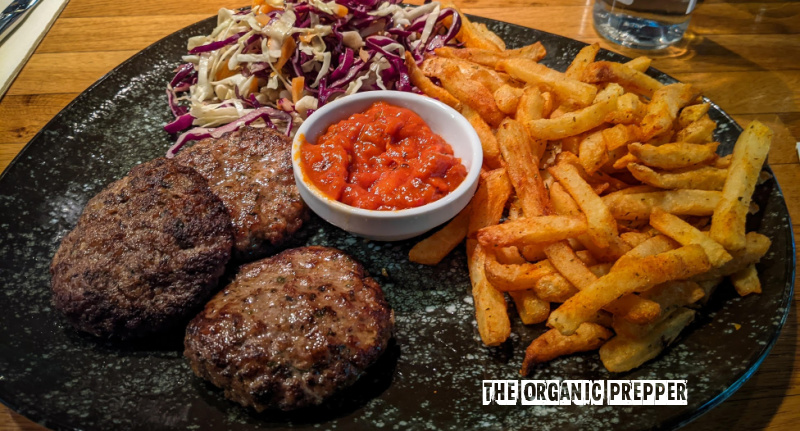
Carbs are king.
Folks in this part of the world are NOT afraid of carbs. If you said that you ate low-carb here they would look at you with confusion and offer you another potato. There is not a meal in sight in a traditional restaurant that doesn’t have at least one filling, delicious carbohydrate.
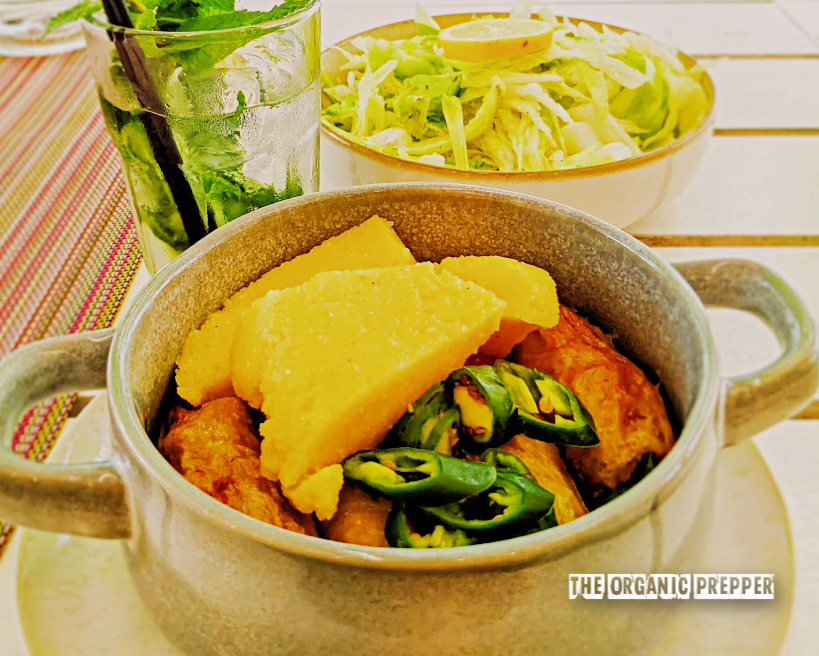
I went to a roadside tavern in Transylvania and ordered a meal that contained smoked meat, cheese, potatoes, AND polenta. It was baked in a clay dish and served as hot as the surface of the sun. There was a side of bread and butter, and of course, a bowl of pickles. It fueled me through a long afternoon of climbing ten billion steep tiny steps while touring a medieval castle and was absolutely delicious.
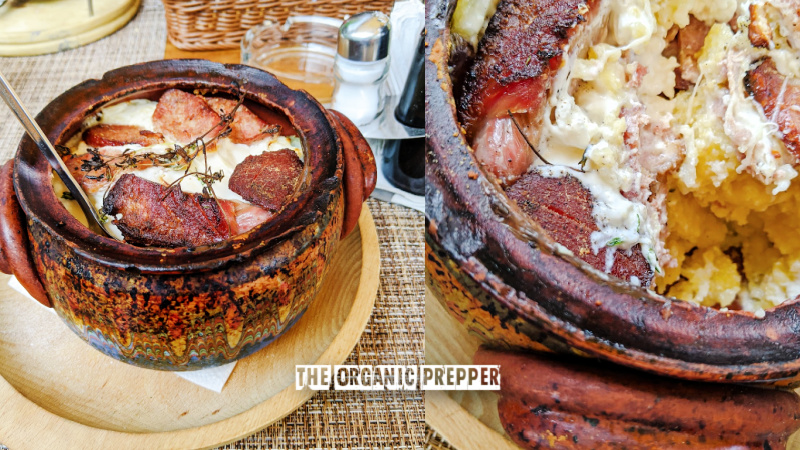
But there’s more to carbs than just giving you energy. They’re cheap and filling, and during difficult times this is more important than ever. As well, if times are tough, there’s a very good chance you’ll be doing a whole lot more physical activity and you’ll need that energy.
You may be thinking, “Carbs are the devil,” or “I’m diabetic, you idiot!” Well if you feel strongly about it, you don’t have to eat them. If you have a health contraindication, you shouldn’t eat them. But be sure you are cutting them out for the right reasons. Whole food should not be scary, and this is a very American way of looking at nutrition.
Dairy is delicious.
I don’t do a whole lot of dairy in the US. I eat occasional cheese because it’s CHEESE, but I use oat milk in my coffee and can’t even remember the last time I had a glass of milk as a beverage.
On my travels, however, avoiding dairy is no easy option. If you asked for oat milk at the cafe they’d look at you in confusion and probably bring you a bowl of oatmeal with milk. You can get a whole lot of different kinds of dairy milk at the grocery store, however, that aren’t always available in the US. Cow’s milk at various levels of pasteurization. Goat’s milk. Sheep milk. If you want a kind of milk, you can generally find it. What they don’t have is half-and-half and other concoctions like that. You can get your milk at 05, 1.5%, or 3.7%.
It’s used liberally in food too. Decadent creamy sauces, rich risotto, velvety polenta, and smooth whipped potatoes are served with nearly every meal. And don’t forget the cheese. Brined cheese, in particular, is very popular, and they don’t skimp on it. If you get a salad that has cheese, you get big whopping slices of it, an amount that I’d normally get for an entire week of Greek salads back home in one delicious dish.
But that isn’t all. Yogurt, sour cream, and kefir were all developed as ways to get a little more life from your dairy products. Cheese in brine can last for up to a year in a barrel in your cold room. Finding ways to use these products will add richness and flavor to your menus, even in hard times.
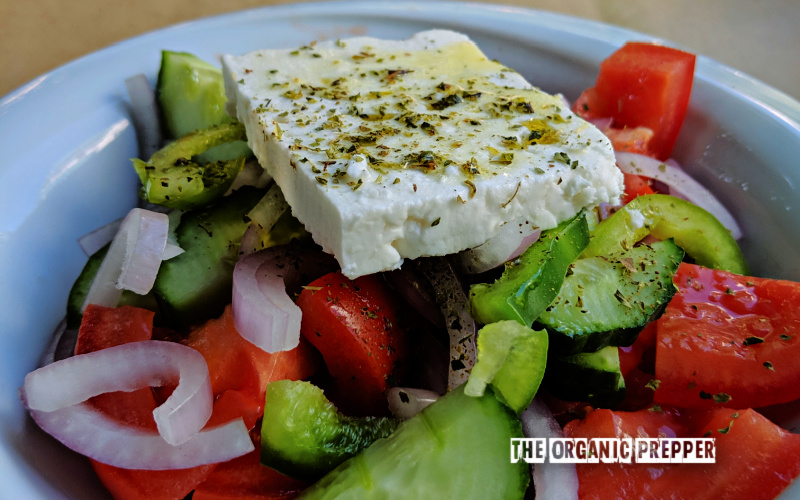
Bread really IS the staff of life.
It’s pretty rare to have a meal here that isn’t served with fresh, delicious bread. The great thing about bread is that it’s filling and provides you with energy, much like our discussion of carbs above. It’s inexpensive, particularly if you’re making it yourself.
And that’s another thing. When I say bread, I’m not talking about those icky cellophane bags from the grocery store shelf. I’m talking about bread that will actually mold in 3 days, and believe me, that’s the kind you want. It shows that every single iota of nutrition hasn’t been filtered out by a processing plant. They sell that kind of bread, but it very clearly says on the label, “TOAST” because Europeans don’t believe it’s fit for any other purpose.
You can make a dish of soup or stew go a whole lot further if you put a rustic loaf of bread on the table with it, and people will look at the meal in a completely different way with this simple addition. So, not only is it filling – it’s also the difference between something that seems sparse and something that makes people excited to sit down for the meal.
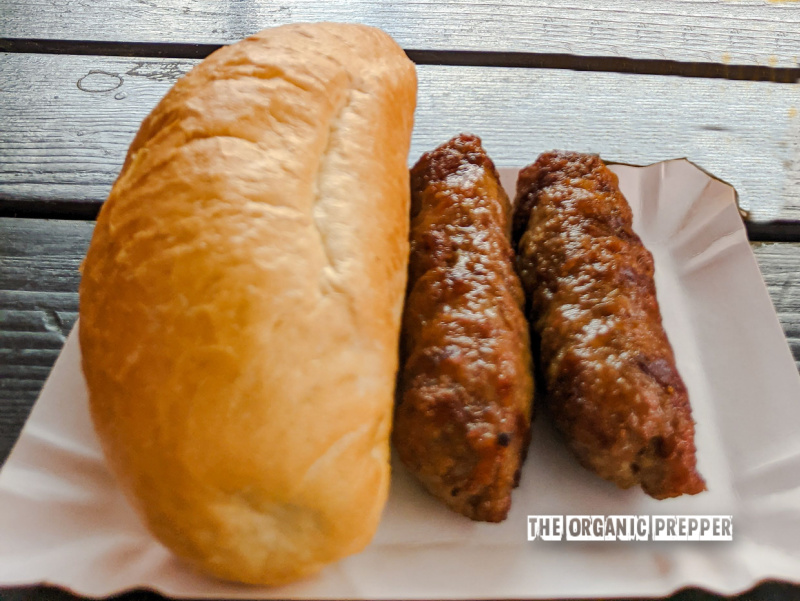
Sip on this.
How do you spot the American in the restaurant?
They’ve got a soda pop in front of them.
Sure, these countries have Coca-Cola and local sodas available, but most commonly, local folks drink the following:
- Water (still or sparkling)
- Coffee/tea
- Beer
- Wine
Going back in time, aside from the sparkling water, these are pretty traditional drinks. As a prepper, these are drinks you can acquire, store, or make. And if you stop buying fruity drinks and soda pop, your screaming grocery budget will thank you.
Simple is better.
When the ingredients are high-quality and best of all, fresh, you don’t NEED to be fancy. They’ll speak for themselves. Maybe add a few seasonings like herbs or sliced jalapenos, but you don’t need tons of added “stuff” or dips. Salad dressing is, most of the time, oil and vinegar that you put on yourself at the table. I was a bit confused as to why all my salads were dry until I realized this. Some salads don’t even need dressing due to the fresh and fabulous ingredients.
I’ve never eaten so much fresh parsley and oregano in my entire life. Back home, we use it mostly as a little garnish, but here it’s chopped up and used liberally to add freshness to a dish.
You can order a bowl of strawberries at a restaurant, and they’re just plain, delicious sliced berries with no syrup or whipped cream. Fresh sliced veggies have chopped herbs and a drizzle of high-quality olive oil. Carbs are topped with butter and black pepper.
If your food is good enough, it can stand on its own. Meals don’t need to be five courses of fancy. A delicious main dish and simple buttered potatoes with a side of fresh veggies is filling and delicious. And there’s nary a Lipton Sidekicks saucy pasta or rice in sight. There aren’t any additives. It’s like stuff your Grandma would’ve served your Grandpa before our kitchens became experiments in industrial food.
Could it be time to rethink the meals you serve?
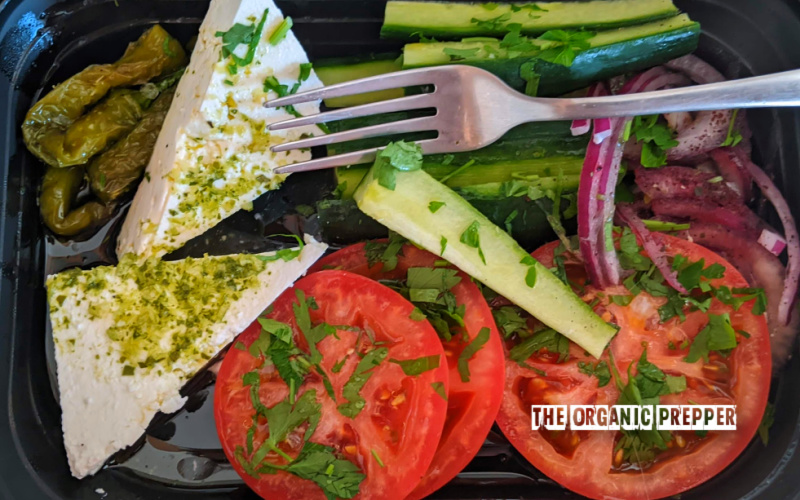
Traditional Food for thought
Over here, you don’t see a lot of vegans and vegetarians. Nobody I’ve encountered eats low-carb or grain-free, or dairy-free. In fact, if you try and order those types of meals in restaurants, they’ll look at you oddly. They’ll nod, and sometimes they’ll try to accommodate you (but not always – there’s a culture of you’ll-get-what-you-get here). I’ve certainly loosened up and simply try to go with the flow and not be too picky.
These things aren’t particularly “foreign” either. They just go back to a time that is largely forgotten in most of the US. This is how our grandparents ate before food became an industrialized product. We, as preppers, are all about the throwbacks – perhaps we need to uncomplicate food and revisit the past.
I hope this missive about traditional food inspires you to look at your diet a little differently if this isn’t how you eat right now. I know that I fully intend to bring home recipes and ideas that I’ve collected, as I’ve done over the years after being influenced by my time in Mexico and other places. Perhaps some of these foods will make their way to your own tables or give you some ideas for your garden goodies.
Do you eat traditional food? What are some of your favorites? How about foods from other countries or cultures? Can you see how you might apply some of this to preparedness? Let’s discuss it in the comments section.
About Daisy
Daisy Luther is a coffee-swigging, adventure-seeking, globe-trotting blogger. She is the founder and publisher of three websites. 1) The Organic Prepper, which is about current events, preparedness, self-reliance, and the pursuit of liberty; 2) The Frugalite, a website with thrifty tips and solutions to help people get a handle on their personal finances without feeling deprived; and 3) PreppersDailyNews.com, an aggregate site where you can find links to all the most important news for those who wish to be prepared. Her work is widely republished across alternative media and she has appeared in many interviews.
Daisy is the best-selling author of 5 traditionally published books, 12 self-published books, and runs a small digital publishing company with PDF guides, printables, and courses at SelfRelianceand Survival.com You can find her on Facebook, Pinterest, Gab, MeWe, Parler, Instagram, and Twitter.

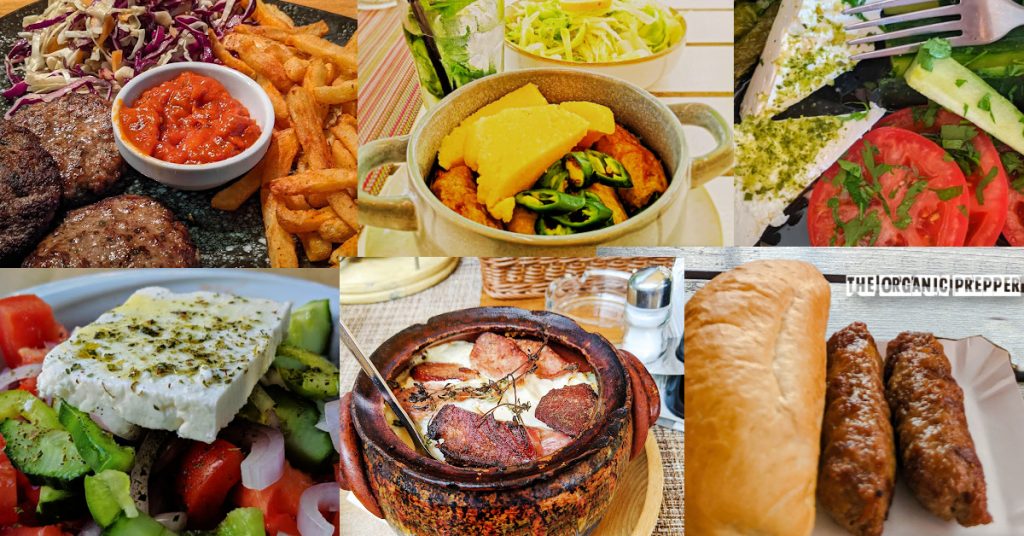















As food prices go up, I’ve been thinking about what my mother cooked. Money was never wasted by either of my parents. Compared to modern standards we were poor, but always had enough to eat. Our fare was mostly plain; no exotic produce and certainly nothing out of season. For years, my mother cooked breakfast every morning, packed our lunches and cooked a full supper,
which included a meat or protein dish or casserole, potatoes, 2 side vegetables, something fresh ( a salad or maybe a dish of sliced tomatoes) and bread and butter. And often a homemade dessert. Every single day. Even now my favorite meal is still pinto beans and cornbread, potatoes, and greens or coleslaw.
Switch out biscuits for cornbread and I’m right there with you for that favorite meal!
Sounds like you are having a wonderful experience. I’ll look forward to your next book. I know most of us in the US don’t believe we’ll need to know about old ways and traditional food, but we will. God bless.
Thank you!
I live in S.Italy. Grew up in the states til 32yrs old and moved here. Culture shock!!!! Big time. 1st…everyone cooks. No ready made meals.
2. Produce is only what is in season…rather was now even that is dying away.
Preppers store canned goods but wouldnt know how to cook dried legumes. When those cans finish …then what?
How can you use fresh potatoes that you’ve grown? Mashed…baked…fries… a cold salad with tomatoes onions and cucumbers (all stuff you can grow) and best of all gnocchis…sauteed with butter and sage…with a normal fresh tomato sauce or even baked alla romana.
Herbs easy to grow…basil pesto…arugola pesto.
Tomatoes..fresh diced tossed with heaping amount of basil..covered in olive oil…a nice dose of a grated savory cheese and tossed with pasta.
Soooooo many foods…REAL foods.
Prep core ingredients… can your homegrown produce. Dehydrated YOUR veggies. Learn to salt cure or smoke meats.
My next project canning fresh tuna in oil. Lasts up to 6 months.
Do not allow those alphabet agencies dictate what and how you store foods. Sterile foods with those vitamin ‘additives’ destroy your body.
Theres is a famous delicacy that now is illegal to sell but can still be found…a semi hard cheese with worms in it. I tried by mistake…was actually quite good but then I saw those critters and couldnt do the second round. Point is ..countries process foods their way yet no one is dead.
Sure not time savers..there are shortcuts but you cant beat flavor AND nutrition.
Oh! I really want to hear how your tuna turns out – please keep us posted!
I wrote it down but need to find…tonnette…its the small tuna…its a sicilian recipe which these fish are easily found there. I’m adriatic side…not sure. Wish me luck 😉
thanks for your knowledge.
I bought several of your books.
Thank you so much!
Sauerkraut. Admittedly, I was a bit intimidated when I first started making it; but its super easy and cheap. You can make it in mason jars, but IMHO the stoneware crocks are better.
Oh nice! I’ve never been a fan of fermented things but I’m trying to add more to my diet.
Yes, yes, yes! I married into a European family and Sauerkraut, smoked sausage, cheese and garlic quickly became my new favourite food. In fact when I did a winter cycling trip (snow) the only way to carry and consume enough food was with high fat foods like smoked sausage and cheese – and I still lost weight!
Thanks for the great article Daisy.
I live in Portugal. Much of what you say about simple but delicious foods in Europe is true. Many people who spend time eating the local foods in Europe don’t realize how processed their typical diet is until they return to the States and develop gastrointestinal issues. Our food in the U.S. is that toxic and the FDA allows terrible things to pass for food that isn’t allowed in other countries.
You’re so very right. It’s like a totally different world of food!
Excellent article Daisy ! Your pictures made me so hungry 😋 it’s not just the fresh food that’s prepared in countries other than the USA . I find a huge taste difference in the quality of breads, cheeses, vegetables, and fruits . It reminds me of the way foods tasted in USA 50 years ago ! So good !
Daisy, have you ever tried the authentic hungarian gulyas or chicken paprikas?
Hungary is just beside Romania, if you are interested in history and great food, hope you will have the opportunity to visit there. Budapest (capital city) is one of the most beautiful city.
Yes – I actually had that in Bulgaria. There was a little restaurant run by an old lady who just had stews and bread in chafing dishes. Very inexpensive and incredibly delicous!
I have had friends and family travel to Europe and parts of East Europe.
They mention nearly everything Daisy mentions.
One additional thing I have heard from friends who were gluten intolerant, they were not in those countries.
Makes one wonder, eh?
Something else, has a long history, generation after generation being on this diet become part of their natural biome or genetics they can eat things that would throw the AMA into fits?
Whereas the US diet that consists mostly of ultra-processed food stuff is the main staple of most Americans.
Food for thought.
I have a Japanese cook book written by chef Masaharu Morimoto (of Iron Chef fame) called the Mastering the Art of Japanese Home Cooking. In the introduction, he mentions as a child, breakfast was commonly a bowl of rice and miso soup. Having spent a bit of time in Japan, I can attest their food is very fresh, little to no additives, and used with the freshest ingredients.
I was recently thinking of trying a different type of diet and, Daisy, I just might try to incorporate some of your observations.
Side note on bread. I have found that if you save a part of your bread dough, place it in a air tight container to make a pre-ferment.
However, after a 2 to 4 days, the dough has been fermenting and will have a alcohol smell to it. If you incorporate this alcoholic pre-ferment into your next batch of bread dough it acts as a natural mold inhibitor. I have had bread that did not mold from 5 to as long as 10 days.
Natural preservation to make your bread last longer. Also, gives the bread a bit more character.
I wrote an article about the bread issue a few years ago. Maybe you’re not gluten intolerant. Maybe you’re poison intolerant. https://www.theorganicprepper.com/maybe-you-arent-actually-gluten-intolerant-maybe-youre-just-poison-intolerant/
I think the difference is that American wheat is soaked in glyphosate and European wheat is not.
Daisy you are 100% right. It took me 3 years and an elimination diet to find out that my stomach issues were because of foods loaded with glyphosate. I make all of our breads, pasta, cakes now with a good quality flour and I have no issues at all. Glyphosates are in so many foods. Grow your own or find farmers that do.
I wonder if they use the older types of wheat, like spelt, in Europe, too?
also, changes have been made in the wheat itself–older wheats grew much taller and tended to lodge (fall over) near harvest due to the weight of the head of grain or wind blowing thru the field. modern wheats are much shorter. what else was bred out of the wheat when that was done?
and what else was ‘bred’ in?
I grew up in a home where both sides of the family were Hungarian. My mother and father were both the first born from each family and the marriage was (for the most part) prearranged and agreed upon by both my grandfathers. So all our fare was Hungarian that hit the table. I didn’t know what a steak was or how to appreciate one u til I was in the suck.
Never been to the old country, but, I will someday.
Every meal on our table was beef,veal,pork, lamb, chicken (all raised on the farm)with potatoes and vegetables (onions and mushrooms mostly..) in a rich goulash (cream based), stew or roast. A dollop of sour cream is on every thing as well as dill. Paprika, it should go without saying, everything. Sweet, smoked, or hot depending on the dish. Fresh and smoked Hungarian sausages, and pickled everything, and I mean everything.. all vegetables, smoked sausage got pickled too.
When I introduced my wife to this food style she was sold immediately and learned my grandmother’s cooking style. Her roasts were the only ones made by a granddaughter that put a satisfied smile on her face.
~50% of our meals are traditional Hungarian still.
I love Hungarian food. It’s so flavorful and unique. Goulash, in particular, is my favorite. A restaurant I went to here had what they called “Hungarian-style cabbage rolls” and the difference was that they weren’t cooked in a tomato sauce. They were fantastic!
I became so enamored with Hungarian gulyas I acquired and grew my own Magyar and Leutschauer pepper seeds for the recipe. And I always laugh at the Americanized gulyas recipes where they only add a tablespoon or two and thats considered a lot. LOL! I always use at least a 1/4 cup or more, resulting in a deep, rich flavor. Old world style has much to offer.
Thank you very-very much for your kind words. 🙂
Actually, goulash is not fully a survival food as it has a need for refrigeration for the meat.
But “Pasztortarhonya”, which is also a traditional Hungarian dish – that is fully a survivalist’s dinner. It has no contents to be refrigerated (well, maybe the sausage, but the Hungarian dried sausage [kolbasz] is fine without refrigeration for, say, some weeks or months). It is easy to prepare and has a lot of nice carbs. The taste is very unique 🙂
Dear Jim, I am not a fan of cities but Budapest is certainly well worth the effort to visit. I am sure you will discover where some of the idiosyncratic mannerisms of your parents/grandparents come from, we did. The food brought back memories and we were welcomed like long lost relatives.
My favorite dish in my Italian family is bread soup. We use leftover bread and leftover veggies. So every time it’s different and no food goes to waste.
I’d love to see a recipe for brined cheese!
“Carbs are King” Unfortunately, for those of us who are diabetic, “carbs kill”.
I wish that more bloggers would not be so harsh about those of us who can’t have carbs…they seem to think that we are being silly about them, or trying to be “fashionable” by doing KETO…maybe some do, but for some of us, carbs can literally kill us. It isn’t an “option” or a choice, it is a necessity. Try to be more tolerant of those who limit or eliminate carbs….
I have been working with my naturopathic doctor for a few years and every time I get bloodwork done, she says I’m eating too many carbs. (blood glucose around 250 for many years) I have cut a LOT of carbs out, but, being part German and Irish, carbs are so difficult to eliminate for me. Rice is the worst, but even wild rice (a grain), quinoa and lentils are bad.
I do believe in the old way of eating, and wish that I could. A lot of these foods are off limits for me, but some are not. I try but it is a struggle sometimes.
I think we’ve all had our fill of being told to be tolerant. Maybe it’s you that should grow some thicker skin. It’s really not a big deal, so get over it. That’s life.
I very clearly stated in the section about carbs:
You may be thinking, “Carbs are the devil,” or “I’m diabetic, you idiot!” Well, if you feel strongly about it, you don’t have to eat them. If you have a health contraindication, you shouldn’t eat them. But be sure you are cutting them out for the right reasons. Whole food should not be scary, and this is a very American way of looking at nutrition.
I truly believe that to be sufficient. Can you imagine all the disclaimers I’d have to add to every single statement if I were to try and encompass every single restriction that people have and why they have that restriction? There’d be more disclaimer than article.
Any reader who is a critical thinker can take what applies to them from an article and leave the rest behind. The entire world of publishing cannot revolve solely around unique situations. If 11% of the American population is diabetic, that leaves 89% of the population who is not diabetic. I’m sorry for your struggles and I know it must be difficult, but this article was not written to slight you or anyone else.
Finally, carbs are king here. That’s simply a fact, not me being harsh. They’re widely included in every single meal. And, incidentally, Romania has half the levels of diabetes by percentage as the United States.
Wishing you the very best in your nutrition and health journey!
Daisy, don’t even bother to reply to the over-sensitive, looking-to-be-offended contingent. I don’t even know what they’re doing here, quite frankly. There are many other things to focus on right now than your previous hurt feelings!
Daisy,
I’m diabetic. But I loved this article! I can just imagine all those nice meals while traveling. How wonderful! This is actually one of my favorite articles. I also love cheese! I’ve never had brined cheese. It sounds interesting and wonderful! I love reading about travels and food in other countries! This was a very interesting article.
Daisy was not harsh, she simply stated a fact, that in the countries she traveled carbs are a crucial part of the diet of the local people.
Nothing at all harsh about that.
I had spaetzle at a Swiss restaurant at Lake Tahoe last winter, and oh, my! was it good (with mushrooms, chives and a veal gravy). It is very traditional, from scratch, as such a prepper food, using common ingredients of flour, egg, milk, and salt. Very adaptable, and quite ordinary in northern or eastern Europe. Essentially it is fresh-made pasta, either scraped off a cutting board into boiling salted water, resembling small caterpillar shapes, or using a dedicated spaetzle maker (more even results, also dropped into boiling salted water). Done in two minutes, max, although many recipes suggest then crisping them in brown butter.
Thank you for sharing, now that I am hungry! In the past year I have been trying to eat more with the seasons and more fresh less processed. It provides variety, makes you think about the seasons, always tastes better and in general can be less expensive.
Enjoying your articles. I always grow a big garden. This year I’ve added many young fruit trees, vine fruits, bushes that make berries or hazelnuts, and a lot more perennial plants. I know how to make a variety of products from dairy. I grew up making all our breads with my mother. We also canned, frozw and dried a large variety of things. I’m going back to that and doing more foraging like we used to do. Luckily my friends like my cooking. My 1600 sq ft garden plus 2000 sq ft area for fruit, berries, and grapes ect. produce far more than two of us need. I even have a small pond area for growing a water rice. I am working on growing more grains. I have grinders for cornmeal and fine flour. I even can butter and milk. My mother taught me to make a wide variety of simple dairy products. I’m very greatful for older parents that grew up on old time farms. Born 1904 and 1907. Grandma was born 1876. They taught me a lot. I haven’t built a smokehouse like my grandparents kept but I’m considering that as well. I’m very fond of soft farmers cheeses with a variety of herbs. Wonderful added to home made pasta or spread on home made bread. I make year and sourdough breads, flour and corn tortillas, quick breads and biscuits. I keep rabbits and chickens as home grown protein sources. I’m enjoying the new chick’s a broody hen hatches out this spring. The one young rooster will be dinner in 2 or 3 more weeks. I already have 2 good roosters. One old guy and a younger one less than a year old. Fresh eggs are wonderful.
Dinner this evening was canned chicken made into a simple sandwich spread with home made mayo, pickles, and lettuce leaves on whole wheat bread. A bowl of sliced tomatoes and celery sticks on the side.
I planted new peas, green beans, spinach, carrots, and radishes yesterday. Thankfully I have a few somewhat shadded areas so peas and lettuce are still possible in this sumner heat.
Daisy, the condiment you call lutenitsa looks a lot like ajvar, which comes from Bosnia and Serbia. You can find it on-line or at any “international food” store (like Phoenicia in Houston, which carries six varieties).
We eat a lot of middle eastern food, which also is made with fresh produce, cheeses, and breads. I’ve been pickling onions and cabbage Turkish style for some of our dinners. I’m looking to can them, too.
It’s VERY similar with the main difference being that ajvar doesn’t have tomato and eggplant. The taste is nearly identical. 🙂
Love this article! My father was from Transylvania and ate the foods you mentioned. Fermented foods were always on the table at every meal! My dad would fondly tell the stories of stone oven baked bread, and lots of sheep cheese!! My parents always made kosher pickles every fall, and sauerkraut, horseradish, cabbage rolls were always food staples. It’s different from North American fast food, but the taste and health benefits are well worth it! Thanks Daisy for the memories, and igniting the spark in me to begin fermenting foods again!
This is how we live. Tomorrow we fly to Slovenia to see some friends who make their own Salamis and I’m taking Jerky and Mango Fruit Leather. We grow most of our own Veg and Fruit. We have Chickens for Eggs and Sheep for Lamb in the freezer. My wife ALWAYS cooks from scratch and we NEVER WASTE ANY FOOD Anything we don’t eat the dogs or Chickens do . Failing that -Compost. The only thing we find about the Med/Balkan diet is not enough Veg and Brown Bread. fortunately freely available . we have been going to Croatia forn17 years now and love the place and the people. we store, preserve and ferment pickles and Anyone can do it. I find it fascinating how far apart we Europeans are from Americans in daily food habits.
Greetings: I am in Serbia at the moment; the food is basic in a general sense, and there is also a mix of dishes from Bulgarian cooking style as well. Of course, there are the junk “food” outlets as well. Also, one needs to be careful about the potable water as well; some good, some not-so-good throughout the Balkans.
Great links to bookmark: https://organicconsumers.org/get-your-one-health-token-from-the-world-health-organization/
https://www.bitchute.com/video/XyasETwRHJ1t/
https://www.bitchute.com/search/?query=control%20the%20food%20supply&kind=video&sort=new
I wish I could post pictures. The link to the Lutenitsa caught my eye and I made about 4 gallons of it and jarring it up today! So tasty! Great on triscuits, toast, cream cheese bagels, etc. Love it!
Thanks for posting the links. How exciting your travels are!
Stay Safe!
Yummy! You’ll have many delicious snacks from that!
Since it takes about 4 hours with our single over to roast everything, I thought I better go big and jar it up.
I highly recommend adding roast Hatch, NM Green Chiles with the other ingredients. I split the batch and the Green Chiles added a lot of depth to the flavor.